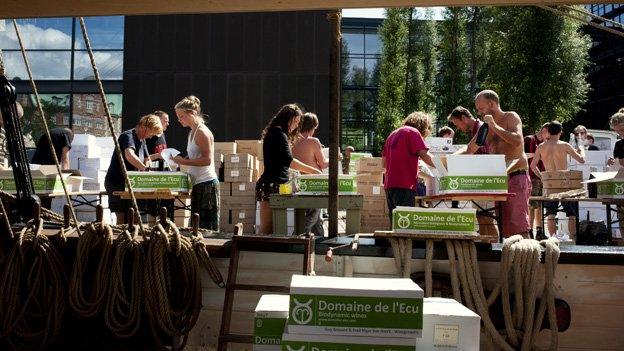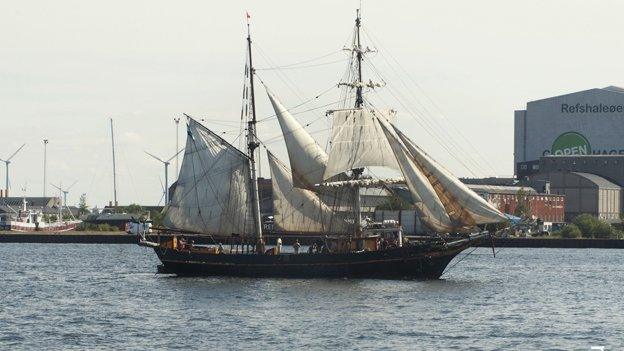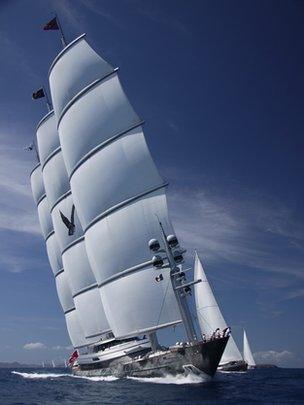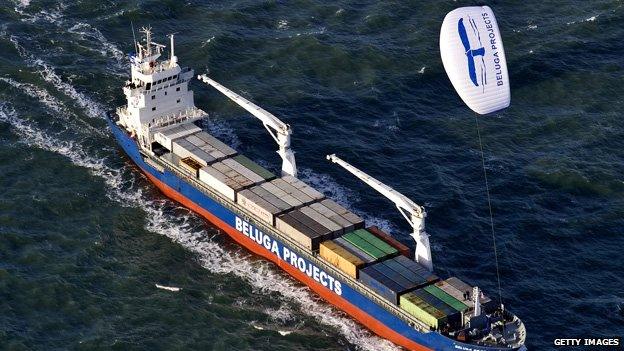Sailing into the future of global trade?
- Published

We are sailing: French wine is unloaded in central Copenhagen, having made the journey by brigantine
"We wanted to keep the energy that the producers had already put in the wine, and not break the chain. And, I'm telling you... this wine just tasted amazing."
On a warm summer's day in August, Danish wine merchant Sune Rosforth took delivery of 8,000 bottles of wine that had arrived from France.
From the offices of financial institutions flanking the quay, workers looked out at something that had not been seen in central Copenhagen for many years.
The ship that had brought the wine from the Breton port of Brest was a 32m-long brigantine, a twin-masted sailing ship, called the Tres Hombres.
Mr Rosforth's company, Rosforth and Rosforth, supplies restaurants in Denmark with organic and biodynamic wines.
Moving wine in a more eco-friendly fashion was something he had been talking about for some time with an Anjou wine producer who was also a skipper, but the plan had originally been to use canal barges.

Shipshape: The Tres Hombres has a cargo capacity of 35 tonnes, and accommodates five crew and 10 passengers
"One day he called us to tell us that there was an opportunity to get the wine finally shipped by a boat, but it was going to be a sailing vessel," he says. "So we said, 'Fantastic, let's go!'"
Sailing ahead
In 2008 a company called Compagnie de Transport Maritime à la Voile (CTMV) announced plans to ship French wine by sailing boat, external. Several shipments took place but the company folded in 2010, external.
But this hasn't stopped other companies trying their luck.
The Tres Hombres set sail in 2009 from Amsterdam and has been shipping cargo ever since. It also gives land-lubbers the chance to sign on as part of the crew for a fee.
The wine shipment was planned with their business partners, the sailing freight transport company TransOceanic Wind Transport (TOWT). The company works with a small fleet of sailing ships, and provides buyers with a means of tracking the journey the goods take.

TOWT's Guillaume Le Grand sees rising oil prices pushing up the cost of traditional cargo options
"It's not some sort of adventurous poetic revival of 19th century technology, on the contrary it's something that is definitely addressing energy transition at sea," says TOWT founder Guillaume Le Grand.
The maritime industry is estimated to produce 3%-5% of global carbon dioxide emissions - making sailing very attractive to the organic and eco-friendly sector.
But as the price of oil rises, so does the cost of traditional cargo options.
This has led to research into alternative fuels such as liquefied natural gas (LNG), and a slowdown in the speed at which cargo freighters move at - a practice known as slow steaming, external.
For Mr Le Grand this all adds up to opportunity.
"Until 10-12 years ago, most of the ships were crossing oceans at about 20 knots average speed. Now they're going down below 15 knots," he says.
"[The Tres Hombres] crosses the ocean at 8 to 10 knots. It's not something that's ridiculous in terms of speed."
There are other challenges. Arrival times are unpredictable, capacity is limited, and at the moment sail shipping is relatively expensive.
"We are using solutions of the 19th century to speak to people of the 21st century," says Mr Le Grand.
"Tres Hombres is a statement. They know very well it's a 32-metre brigantine, which is small, but they are paving the way for shipping cargo by sailing ships."
The only way to become competitive, he says, will be to build a large fleet of large cargo ships.
The team behind the Tres Hombres are looking at doing just that, with plans for a modern sail-powered cargo ship called the Ecoliner, external.
Get on board
They are not the only ones.
B9 Shipping's Diane Gilpin has been working on plans for a sail-powered cargo ship since 1994.

The Maltese Falcon superyacht is fitted with computer-controlled carbon-fibre sails
She was inspired by The Atlantic Clipper, a sail-assisted cargo ship that sailed between the UK and the Caribbean in the 1980s.
"What I think we need to be looking at is the significant impact on global greenhouse gas emissions. A recent study showed that if [the global shipping fleet] was a country, it would be the sixth-largest emitter in the world," she says.
The world needs to develop a technology that is capable of moving commodities in significant quantities in order to address this challenge, she says.
The answer that B9 is proposing is a coastal cargo ship that combines massive carbon-fibre DynaRig sails - such as those used on the superyacht, the Maltese Falcon, external - with an engine that runs on bio-gas made from food waste using a process called anaerobic digestion, external.
The liquid bio-methane produced by this process can be used in an existing LNG engine.
"Effectively, we are combining technology that already exists in a way that will enable us to build a 100%-renewably-powered cargo vessel immediately," she says.
The company hopes the vessel will sail 60% of the time.
Using bio-gas means they can more accurately predict operational costs, says Diane Gilpin. This has also meant working closely with the British Met Office on sophisticated weather routing products.
A scale model of the vessel was tested over the summer at Southampton University. The results are being used to predict performance and to optimise routes.
Richard Pemberton, a research engineer at the university who took part in the testing, says he feels the project has potential.

The B9, including its sails, will be fully controlled from the bridge, but is "no silver bullet" says Diane Gilpin
"[With] the right cargo on the right route, then sail power becomes viable, particularly if fuel costs just get higher and higher," he says.
Mr Pemberton doesn't see hybrid sailing ships taking over quite yet however.
"Some of the cargo will still be shipped with normal fossil fuels," he says.
Let's sail away
As well as numerous small-scale projects, external, commercial attempts to harness wind power are on the increase.
A German company called SkySails, external is already marketing a system that uses a giant kite to help tow commercial shipping, cutting fuel consumption.
In Japan the Wind Challenger project, backed by the University of Tokyo,, external is also looking at fitting sails to cargo ships.
Nick Brown, of shipping experts Lloyd's Register, says the society is seeing a lot of interest in wind technology.
"I think it comes down to a commercial decision, on a combination of investment cost and the implications for probably longer sailing times," he says.
According to Mr Brown, when it comes to "cleaner" forms of propulsion, choice is limited.
"If there are no ships, there is no world trade. Half the world freezes, the other half starves.

Let's go fly a kite: The MS Beluga Skysails was the first ship fitted with the computer-operated SkySail technology
"The big risk is the view on carbon emissions, because LNG is hugely beneficial - much, much cleaner than alternative fossil fuel options available at the moment - but [it is still] a fossil fuel," he says.
"And obviously nuclear power has been used successfully in applications by navies for more than 40 years, but there's a big political and societal block to it being adopted more widely. So, the focus is much more on renewables. And wind is potentially really exciting."
For now, using sail technology in commercial shipping remains something of a niche. But rising oil prices, and the resulting slower speeds at which international freight moves, could all push its economic viability.
"The shipping industry isn't an emotional industry whatsoever, it is purely commercial," says Southampton University's Richard Pemberton.
"If someone could make money out of [sail technology] and get a good return, then they'll back it. It is that simple. And the big shipping companies are very interested in it, so they must see some potential in it making money."